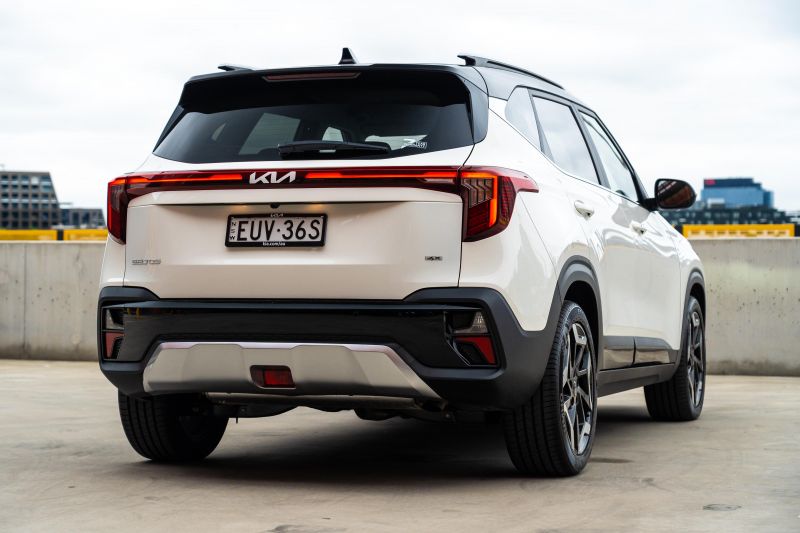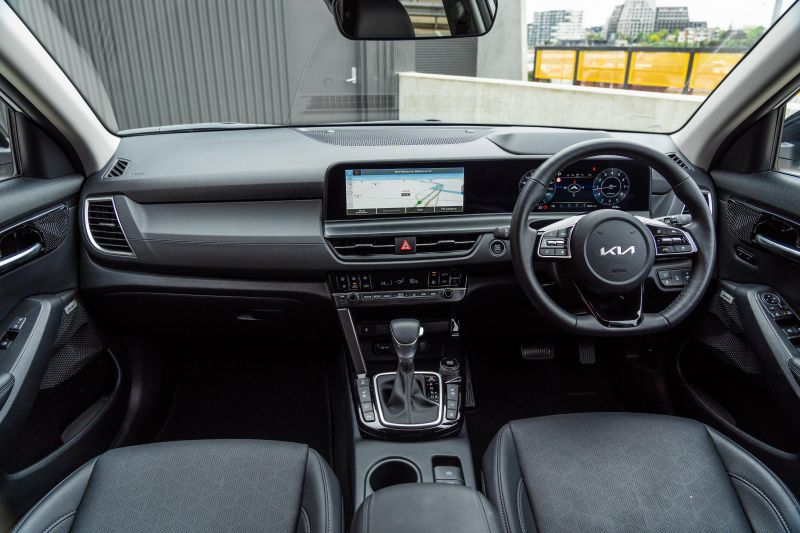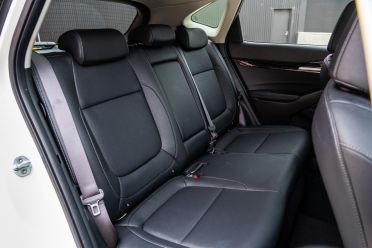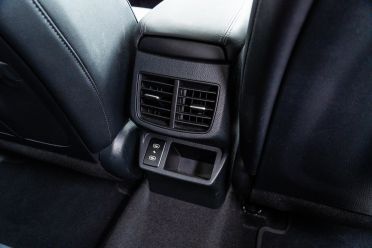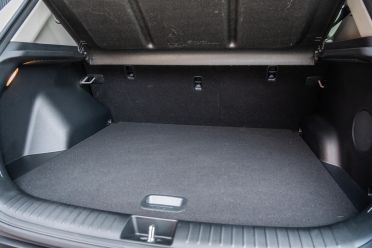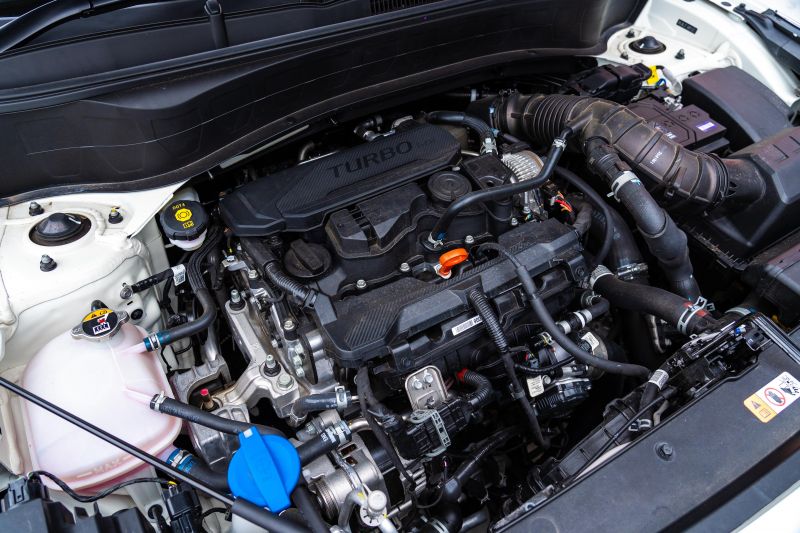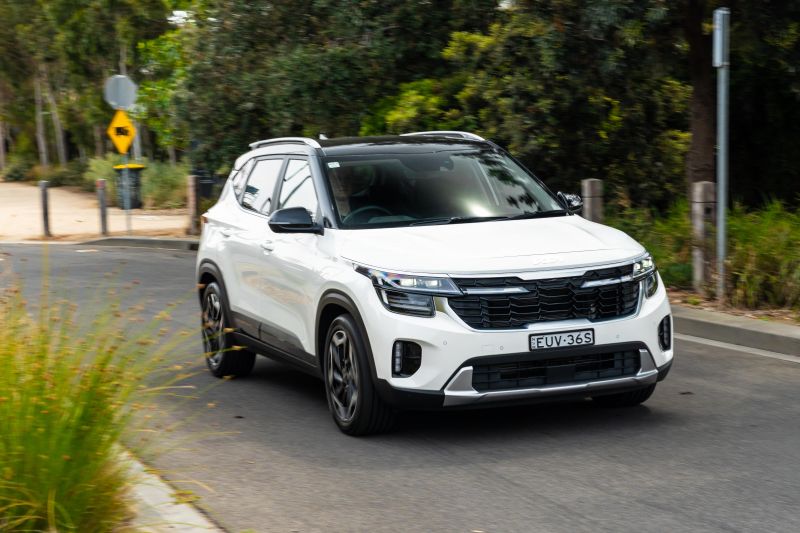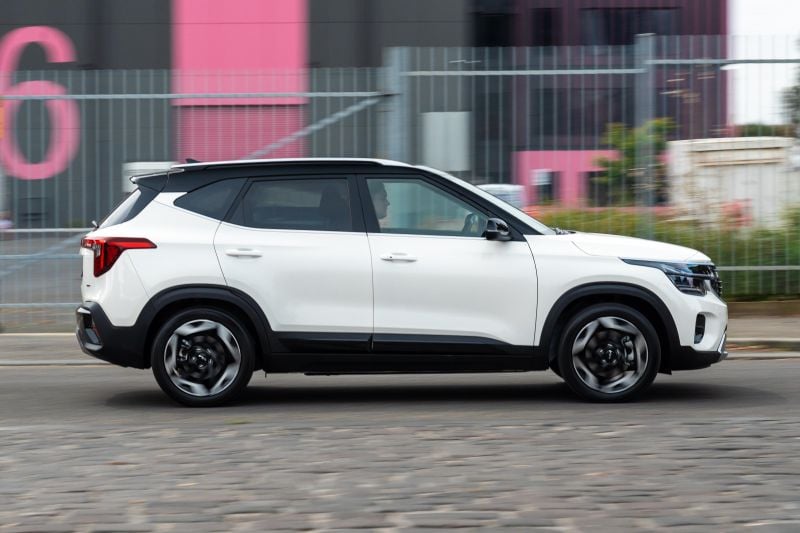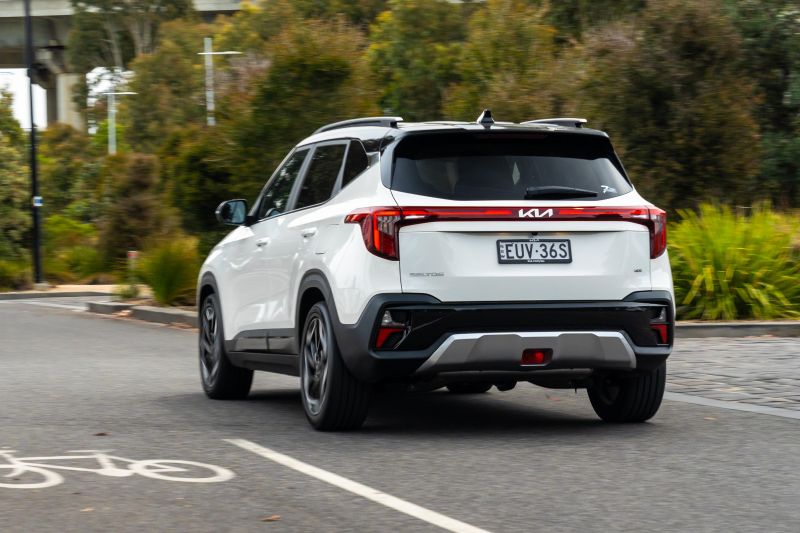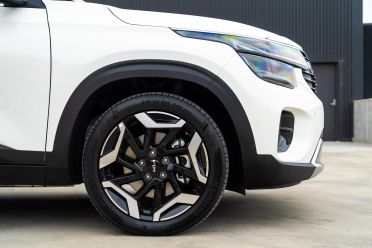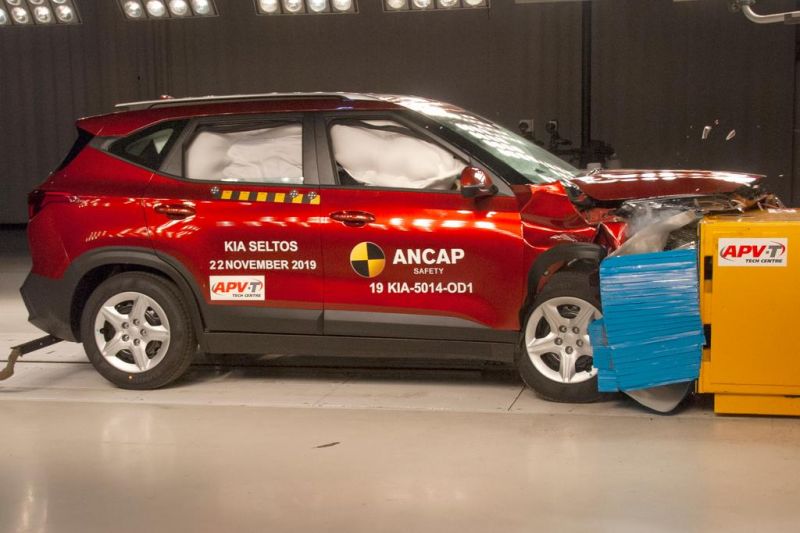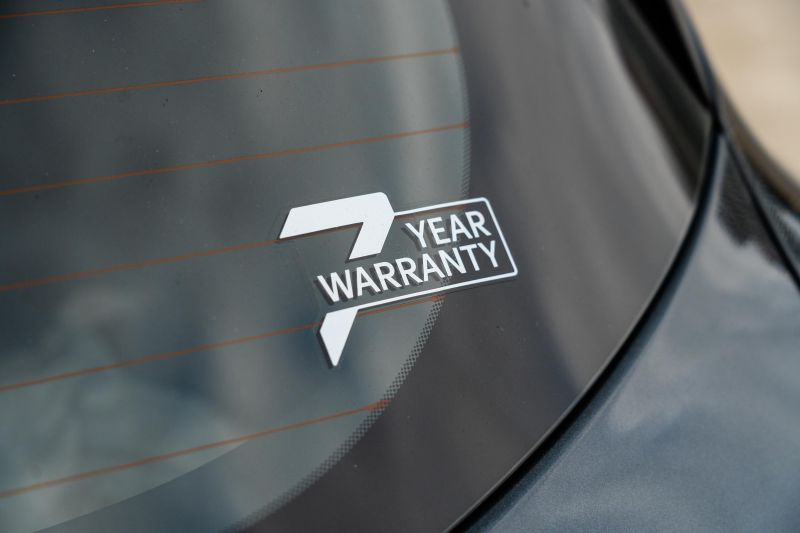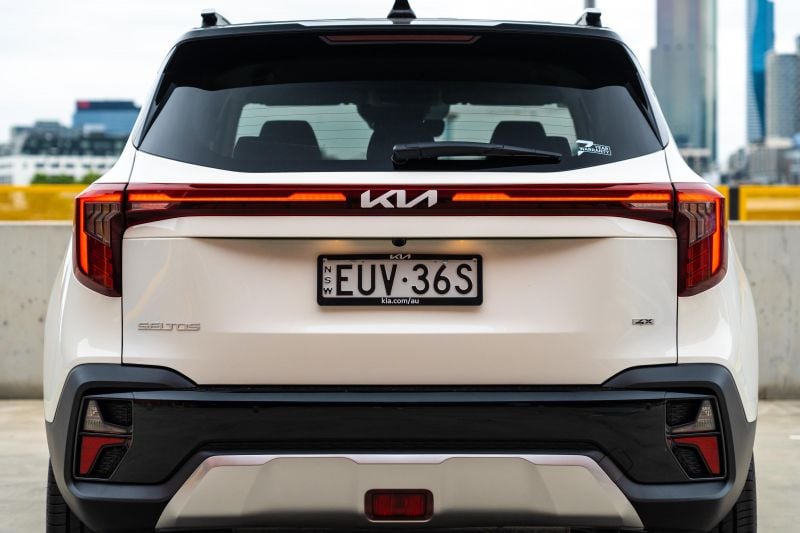When is less more? Kia is asking that question with the updated Seltos GT-Line SUV.
Along with more technology and a fresh look on the outside, last year’s update to the Seltos brought a new engine option to the GT-Line – a less powerful, less expensive 2.0-litre four-cylinder lifted from lower models in the range.
Not only is it cheaper than the more powerful 1.6-litre turbocharged engine that was previously the only option in the GT-Line, it’s more efficient in standardised testing. On paper it’s a compelling option.
We’ve hopped behind the wheel of the turbocharged range-topper to investigate whether it’s been usurped by the new kid on the block.
How does the Kia Seltos fare vs its competitors?
View a detailed breakdown of the Kia Seltos against similarly sized vehicles.
Kia
Seltos
How much does the Kia Seltos cost?
- 2024 Kia Seltos S 2.0 FWD: $29,500 ($31,690 drive-away)
- 2024 Kia Seltos Sport 2.0 FWD: $32,700 ($35,390 drive-away)
- 2024 Kia Seltos Sport+ 2.0 FWD: $35,800 ($38,490 drive-away)
- 2024 Kia Seltos Sport+ 1.6T AWD: $39,300 ($41,990 drive-away)
- 2024 Kia Seltos GT-Line 2.0 FWD: $41,500 ($44,590 drive-away)
- 2024 Kia Seltos GT-Line 1.6T AWD: $44,900 ($47,690 drive-away)
All prices are before on-road costs.
To see how the Seltos compares with its rivals, line it up side-by-side with any car you want using our comparison tool.
What is the Kia Seltos like on the inside?
The pre-update Seltos already had one of the better small SUV cabins, and the facelifted model has taken another step forward.
The dual widescreen displays are integrated into a slick single panel, and the redesigned centre console is cleaner and easier to use than before. There’s a hint of Mercedes-Benz to the design, down to the configurable ambient lighting.
It’ll even pulse in time with the sound system if you enjoy being distracted by your car’s dashboard at night.
Behind the flashy bits, the fundamentals are good here. Front passengers sit in generously padded seats set high, for a commanding view of the road, and most of what you grab feels high quality. The wheel is trimmed in leather, as is the gear knob, and most of the places you rest your elbows are nice and soft.
Kia deserves credit for sticking with buttons for the climate controls. It’s easy to punch on your heated or cooled seat without taking your eyes off the road, because there’s a big button next to the gear lever, rather than a tiny icon on a distant display.
Kia’s new infotainment system is a mixed bag. On the plus side, it looks polished and responds quickly to inputs. The graphics are all handsome, and it’s full-featured.
But the lack of wireless smartphone mirroring has been hard to understand for a while now, and it’s hard to excuse as we swing into 2024. Yes, you get factory navigation (capable of showing live traffic data), but it’s no match for Google Maps – and there’s no substitute for being able to respond to text messages using your phone’s native voice control.
The digital instrument cluster offers most of the information you need, but it’s not a patch on what’s on offer in the latest Volkswagen Group products. Likewise the head-up display, which is projected on a piece of glass instead of the windscreen like in new Mazda cars.
The amount of storage on offer is good. There’s a shelf under the centre stack large enough for an oversized phone or wallet, along with adequately-sized cupholders between the front seats, and a fairly deep console bin. The door bins are on the shallower side.
One USB-A and one USB-C port feature up front, along with a 12V plug. A wireless phone charger features under the dash; although, you can’t actually use it if you want to use Android Auto or Apple CarPlay.
This is a bigger take on the small SUV formula, with lots of legroom and headroom for passengers in the rear seats.
The wide-opening rear doors and tall windows make this one of the better small SUVs out there for families with tight parking spaces, and mean you’ll more easily be able to load children or bulky child seats than in some rivals.
You get two ISOFIX points and a trio of top tethers back there. USB-C ports and air vents feature too, which will keep kids happy on long, summer road trips.
When we first drove the Seltos it was a bit of an outlier, but the competition has caught up. The new Hyundai Kona is bigger than before, as is the new Nissan Qashqai. In that context the Seltos is still good, but it’s not quite the standout it once was.
Claimed boot space is 433 litres, and there’s a full-sized spare wheel under the floor. Folding the rear bench (60/40) expands that to 1393 litres.
What’s under the bonnet?
The 1.6-litre engine in the Seltos GT-Line is the range-topping option, and the only engine paired with all-wheel drive. The range is also offered with the naturally aspirated 2.0-litre engine discussed earlier, which is hooked up to a CVT and front-wheel drive.
| Model | Kia Seltos GT-Line 1.6T AWD |
|---|---|
| Engine | 1.6L 4cyl turbo |
| Power | 146kW |
| Torque | 265Nm |
| Transmission | 8-speed automatic |
| Driven wheels | All-wheel drive |
| Weight | 1495kg (tare) |
| Fuel economy (claim) | 7.4 litres per 100km |
| Fuel economy (observed) | 10.5 litres per 100km (city) |
| Fuel tank size | 50 litres |
| Fuel requirement | 91 RON |
To see how the Seltos compares with its rivals, line it up side-by-side with any car you want using our comparison tool.
How does the Kia Seltos drive?
More power is usually a good thing, but it doesn’t necessarily make for a better Seltos.
The good news is, the switch from a dual-clutch transmission to a conventional automatic makes the GT-Line feel more natural. Rather than stuttering off the line, and awkwardly getting caught between first and second gears, the turbocharged Seltos feels more at home in the city than before.
The light steering, solid visibility and high-resolution reversing camera make parking in tight spaces simple enough, and the Seltos is a great size if you want a reasonably large interior but spend a lot of time on small city streets.
Compared to cheaper models on smaller wheels, the GT-Line feels firmer around the city. It still does a decent job keeping smaller lumps and bumps at bay, but you’re more aware of speed bumps and sharp potholes here because of the skinnier rubber and bigger wheels.
If you’re the sort of driver who treats every traffic light like the start of a drag race, the turbo engine packs more of a punch than the base 2.0-litre engine. The all-wheel drive system means you can put your foot down hard off the mark, and in the wet there’s no wheel spin.
With that said, the gap between it and the base engine is far smaller than you might expect. The more powerful turbo isn’t an engine that loves being pushed hard, with a strained sound and less shove than you’d expect.
The extra grunt does pay off on the highway, though. It makes overtakes with people and luggage on board easier, with less noise and fuss than you get in the 2.0-litre.
Beyond the engine, the Seltos is one of the best if you’re covering long distances. Road and wind noise are kept at bay, and the engine hums away below 2000rpm at the legal limit in Australia.
The GT-Line has a full suite of active driver assists designed to lighten the load on long road trips. The adaptive cruise control system smartly maintains a gap to the vehicle in front, and the lane-keeping assist smartly nudges you back between the white lines when you stray.
Lane-centring is too hands on; however, maintaining an iron grip on the car’s position in a way that feels less like it’s helpful, and more like it’s trying to rip the wheel out of your hands.
While we’re talking about annoying safety equipment, the speed limit warning in the latest Kia and Hyundai products is diabolically bad. Drift over the speed limit and it will beep at you. Drift back below, and then over it again – even by a small margin – and it beeps again.
Drive through a school zone outside of school hours and, even though the 40km/h limit isn’t active, it’ll beep at you for exceeding the school zone limit.
It activates every single time you start the car, and takes multiple button presses to turn off. I’d be looking to the aftermarket to have it coded out, because owners have confirmed it doesn’t get any less annoying the longer you spend with the car.
What do you get?
Seltos S highlights:
- 16-inch alloy wheels
- Spare-saver spare wheel
- Automatic halogen headlights
- Automatic high-beam
- Halogen daytime running lights
- Rear fog light
- Matte Black grille mesh
- Body-coloured door handles
- Body-coloured, power-folding side mirrors
- Roof rails
- Rear spoiler
- Shark fin antenna
- 4.2-inch instrument cluster screen
- 8.0-inch touchscreen infotainment system
- Wireless Apple CarPlay and Android Auto
- 6-speaker sound system
- 12V power outlet in front console
- USB-A and USB-C outlet in front console
- Two USB-C outlets behind centre console
- Manual air-conditioning
- Second-row air vents
- Manual handbrake
- Folding key
- Cloth upholstery
- 6-way manually adjustable driver’s seat
Seltos Sport adds:
- 17-inch alloy wheels
- Full-size spare wheel
- Windscreen and front door Solar Glass
- Halogen (projector-style) front fog lights
- 10.25-inch digital instrument cluster
- 10.25-inch touchscreen infotainment system
- DAB+ digital radio
- Wired Apple CarPlay and Android Auto
- Satellite navigation
- Sounds of Nature
- Kia Connect (7yr subscription)
- Climate control
- Driver window one-touch up and down
- Premium steering wheel
- Premium gear shifter
Seltos Sport+ adds:
- Heated side mirrors
- Privacy glass
- AEB cyclist avoidance and junction turning assist
- Adaptive cruise control
- Keyless entry and push-button start
- Electric park brake with auto-hold
- Auto-dimming rear-view mirror
- LED interior lights
- Illuminated vanity mirrors
- Front centre console armrest sliding function
- Rear centre armrest
- Cloth and artificial leather upholstery
The flagship Seltos GT-Line adds:
- 18-inch alloy wheels
- LED headlights
- LED daytime running lights
- LED fog lights
- LED positioning lights
- LED rear combination tail lights
- Premium Gloss Black grille mesh
- Satin silver belt line
- Tilt and slide sunroof (N/A with two-tone paint)
- Power tailgate
- Rain-sensing window wipers
- Head-up display
- Wireless phone charger
- 8-speaker Bose premium sound system
- Heated, flat-bottom steering wheel
- Interior ambient lighting
- Parcel shelf
- Premium artificial leather upholstery
- Heated and ventilated front seats
- 10-way power driver’s seat
- 2-way power lumbar support
- 2-position memory
- 8-way power front passenger seat
Is the Kia Seltos safe?
The Kia Seltos was crash tested by ANCAP in 2019 and received a five-star safety rating.
It received an adult occupant protection score of 85 per cent, child occupant protection score of 83 per cent, vulnerable road user protection score of 61 per cent, and a safety assist score of 70 per cent.
All models come standard with the following safety features:
- Front, front-side and curtain airbags
- Autonomous emergency braking (AEB)
- Blind-spot assist
- Rear cross-traffic assist
- Safe Exit Warning
- Intelligent Speed Limit Assist
- Lane-keep assist
- Lane Following Assist (lane centring)
- Driver Attention Alert
- Front and rear parking sensors
- Rear-view camera
- Tyre-pressure monitoring system
Sport+ and GT-Line models receive AEB with cyclist avoidance and junction turning assist, as well as adaptive cruise control and lead-vehicle departure alert.
How much does the Kia Seltos cost to run?
The Kia Seltos is covered by a seven-year, unlimited-kilometre warranty, with seven years of capped price servicing and up to eight years of roadside assist if you service the car at an authorised Kia dealer.
Servicing is required every 12 months or 10,000km when you opt for the turbo, down from 15,000km in the base engine.
The first seven services in the 1.6-litre are capped at $309, $502, $375, $653, $348, $632 and $673 respectively.
CarExpert’s Take on the Kia Seltos
This is not the Seltos to buy unless you absolutely need all-wheel drive.
Although it retains the strengths of the broader range, the GT-Line 1.6T AWD gets more performance… at the cost of economy, and driveability.
It’s just a bit awkward, even after Kia swapped the stuttering dual-clutch transmission for an eight-speed automatic. The good news is, Kia now offers the GT-Line in combination with their less powerful 2.0-litre naturally-aspirated engine.
If you’re after a spacious, well equipped compact SUV, the Seltos GT-Line remains a strong choice. Unless you really need all-wheel drive, it’s a more compelling package without the turbo engine on test here.
Click the images for the full gallery
BUY: Kia Seltos
MORE: Everything Kia Seltos

